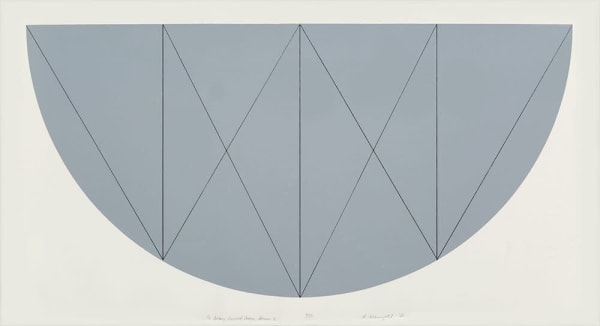-
Rukaj Gallery is pleased to present Less | Minimalist Aesthetics, a survey of painting and drawing circa 1960-70 that investigate minimalist forms and composition. The show includes works by Ken Noland, Robert Mangold, Burgoyne Diller, Géneviéve Claisse and Roy Kiyooka.
-

-
-

-
“ONE OF THE PROFOUND POWERS OF THE ARTIST IS THAT HE CAN WILL OR CHOOSE TO BECOME ANYTHING HE WILLS OR CHOOSES. IT DOESN’T COME FROM HIS SOUL, OR FROM HIS GENES, IT COMES FROM HIS CHOICES.”
– AL HELD
-
In the early 1930s, Diller began a long career with the various incarnations of the Works Progress Administration (WPA), which became a vital way for him to support himself as an artist. Diller championed abstract art and oversaw the execution of more than 200 public murals, most of which were completed as part of his largest undertaking: in the late 1930s, he supervised the artwork for the Williamsburg Housing Project in Brooklyn (1937-1939). Among the principal artists Diller selected for this project were Jan Matulka, Stuart Davis, and Paul Kelpe, who were all permitted to execute their own designs. For Diller, abstraction was “the ideal realm of harmony, stability and order in which every form and spatial interval could be controlled and measured.”
-

-

-
The show also features a stunning 1965 work by Jack Youngerman. Youngerman’s canvases got bigger and bolder, with jagged slashes of strong color shapes in white, black, orange, blue, and red, as if the paint were large pieces of torn paper glued to the page. Though he didn’t draw from nature and wanted to invent shapes, his forms suggest movement and life: flames, a wing, something blooming or opening. Youngerman told Barbara Rose in a 1966 interview that he tried to “let things happen spontaneously, to allow the shape to burst into being.” Kelly and Youngerman were chosen by MoMA curator Dorothy Miller to appear in Sixteen Americans in 1959, part of her influential series of exhibitions showcasing emerging talent. (Youngerman remembered the generosity of her visit to his out-of-the-way studio, and her climbing up the precarious ladder to the fifth-floor space in heels.) He was the only artist without an accompanying text in the catalouge—he was too modest to ask someone to write for it, and too modest to write his own statement.
-
-

-
-
Geneviève Claisse explored pure abstraction and formal perfection through bold, geometric forms. The French artist’s pursuit of abstraction extended to energizing the two dimensional surface through movement and numerous shapes. Circles and triangles, persistent motifs in her work, are depicted as independent and overlapping forms altered by varied hues in simplistic compositions such as Cercle Relief Rouge (1971–1975). Her works are meticulously created, resulting in a delicate harmony of color and form. She purified forms and colors in a parallel investigation to the artists working in Optical Art and Kinetic Art. She studied at the École des Beaux-Arts and worked as an assistant to Auguste Herbin, her great uncle and founder of the Abstraction-Création group.
-

-
Claisse is collected by several major instutions including Centre Pompidou, Louisiana Museum of Art, Hirshhorn Museum and Sculpture Garden, Moderna Museet, and Stockholm Art Museum.
-
-
Robert Mangold’s subtle abstract paintings—which are derived from ideas of geometry and asymmetry in shape and form—challenge the limits of the two-dimensional discipline with irregularly shaped canvases, cut-outs in the middle of canvases, subtly modulated planes of color, and architectural scales. Mangold is associated with the Minimalist movement, and he incorporates classical compositional elements into his non-objective works; they have variously taken inspiration from ancient Greek pottery and Renaissance frescoes.
-
Less | Minimalism 1960.1970 will be on view November 12 - November 22







